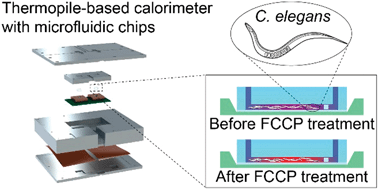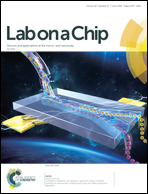Dynamic microfluidic nanocalorimetry system for measuring Caenorhabditis elegans metabolic heat†
Abstract
Basal heat production is a key phenotype for assessing the metabolic activity of small living organisms. Here, we present a new nanocalorimetric system, based on thin film thermopile sensors combined with microfluidic chips for measuring metabolic heat signals generated by Caenorhabditis elegans larval populations (60 to 220 organisms). In addition to versatile on-chip fluidic manipulation, our microfluidic approach allows confining worm populations close to the sensor surface, thus increasing the sensitivity of the assays. A customized flow protocol for dynamically displacing the worm population on-chip and off-chip was applied. The resulting sequential recordings of heat source and reference signals enabled precise measurements of slow varying heat-generating metabolic processes. We found an increase of the volume-specific basal heat production from the L2 to the L3 larval stage, and a significant decrease from the L3 to the L4 stage. Additionally, we investigated the metabolic heat production of the larval populations during maximal respiratory capacity, i.e. after inducing uncoupled respiration by on-chip treatment with the mitochondrial uncoupling agent carbonyl cyanide 4-(trifluoromethoxy)phenylhydrazone (FCCP). Depending on the larval stage, inducing uncoupled respiration causes an increase of the metabolic heat production ranging from 55% up to 95% with respect to untreated worms.



 Please wait while we load your content...
Please wait while we load your content...